Non-Real-Time Wireless System for Lightning Effect Measurements
Abstract
:1. Introduction
2. Theory
3. Conception of Measuring System
4. Prototype
5. Results
6. Discussion
- This solution is resistant to induced overvoltage, LEMP, and it provides galvanic separation, which results in greater convenience of use compared to the systems using coaxial cables or optical fibers.
- The voltage/current measurement accuracy compared to the oscilloscope (reference device) is 85%. This value provides a good representation of the recorded mileage (work on improving this value is ongoing).
- It was possible to develop a measurement system with a very good representation of the signal value (16 bits of resolution) with a sampling rate of 16 MS/s. This device was designed to work with lightning generators where waveforms up to 500 kHz are used.
- This is a very specific application that allows you to quickly change the measurement site (without cables in which interference propagates) and the joint operation of many measurement probes without the need for power supply.
- There are many applications of the proposed solution: working in the open space, measuring objects in motion, the possibility of mounting the device on a drone or a weather balloon. The device can be used for measurements in aviation, construction, automotive, wind farms, telecommunication masts and many others.
- There is the possibility to select the measuring range by using an appropriate divider at the device input.
- The most important aspect is to protect the life and health of researchers. The prototype also protects expensive measuring equipment against unexpected surges.
Author Contributions
Funding
Institutional Review Board Statement
Conflicts of Interest
References
- Bogucki, J.; Chudziński, A.; Połujan, J. Electromagnetic emission of devices in practice. Telekomun. Tech. Inf. 2007, 1–2, 85–95. [Google Scholar]
- Masłowski, G.; Wyderka, S. Układ probierczo-pomiarowy do poligonowych badań narażeń piorunowych. Prz. Elektrotech. 2012, 88, 67–72. [Google Scholar]
- Wang, J.; Li, Q.; Yan, J.; Ding, Y.; Lu, Y.; Zhang, Y.; Wan, H. Power-over-fiber technique based sensing system for internet of things. In Proceedings of the 15th International Conference on Optical Communications and Networks (ICOCN), Hangzhou, China, 24–27 September 2016; IEEE: Piscataway, NJ, USA, 2016; pp. 1–3. [Google Scholar]
- Kimovec, R.; Helmers, H.; Bett, A.W.; Topič, M. Comprehensive electrical loss analysis of monolithic interconnected multi-segment laser power converters. Prog. Photovolt. Res. Appl. 2019, 27, 199–209. [Google Scholar] [CrossRef]
- Lin, T.; Uman, M.A.; Tiller, J.A.; Brantley, R.D.; Krider, E.P.; Weidman, C.D. Characteryzation of lightning return stroke electric and magnetic fiels form simultaneous two-station measurements. J. Geophys. Res. 1979, 84, 6307–6314. [Google Scholar] [CrossRef]
- Anderson, R.B.; Eriksson, A.J. Lightning parameters for engineering application. CIGRE Electra 1980, 69, 119–129. [Google Scholar]
- Maslowski, G.; Rakov, V.A.; Wyderka, S.; Ziemba, R.; Karnas, G.; Filik, K. Current impulses in the lightning protection system of a test house in Poland. IEEE Trans. Electromagn. Compat. 2015, 57, 425–433. [Google Scholar] [CrossRef]
- Filik, K. Badanie odporności zespołów awioniki statków powietrznych na narażenia LEMP. Prz. Elektrotech. 2014, 90, 60–63. [Google Scholar]
- RTCA DO-160. Environmental Conditions and Test Procedures for Airborne Equipment; Radio Technical Commission for Aeronautics: Washington, DC, USA, 2010. [Google Scholar]
- PN-EN 62305-1:2011. Lightning Protection—Part 1; BSI Standards Publication: London, UK, 2011. [Google Scholar]
- PN-EN 61000-4-5:2014-10. Electromagnetic Compability (EMC)—Part 4–5: Methods of Research and Measurement—Shock Resistance Test; International Electrotechnical Commission: Geneva, Switzerland, 2014. [Google Scholar]
- Hacker, P.T.; Plumer, J.A. Measurements and analysis of lightning-induced voltages in aircraft electrical circuits. SAE Trans. 1970, 79, 2735–2752. [Google Scholar]
- Charlton, D.; Clarke, S.; Doucet, D.; O’Sullivan, M.; Peterson, D.L.; Wilson, D.; Bélanger, M. Field measurements of SOP transients in OPGW, with time and location correlation to lightning strikes. Opt. Express 2017, 25, 9689–9696. [Google Scholar] [CrossRef]
- Moore, C.B.; Rison, W.; Mathis, J.; Aulich, G. Lightning rod improvement studies. J. Appl. Meteorol. 2000, 39, 593–609. [Google Scholar] [CrossRef] [Green Version]
- Beaulne, D.; Fotopoulos, G.; Lougheed, S.C. Impacts of light detection and ranging (LiDAR) data organization and unit of analysis on land cover classification. Int. J. Remote Sens. 2021, 42, 2532–2555. [Google Scholar] [CrossRef]
- Koutsourakis, G.; Eales, T.D.; Kroeger, I.; Blakesley, J. High resolution linearity measurements of photovoltaic devices using digital light processing projection. Meas. Sci. Technol. 2021, 32. [Google Scholar] [CrossRef]
- Liu, C.; Dutton, Z.; Behroozi, C.H.; Hau, L.V. Observation of coherent optical information storage in an atomic medium using halted light pulses. Nature 2001, 409, 490–493. [Google Scholar] [CrossRef] [Green Version]
- Zia, M.T. Visible light communication based indoor positioning system. TEM J. 2020, 9, 30–36. [Google Scholar] [CrossRef]
- Pittalà, F.; Stone, C.; Clark, D.; Kuschnerov, M.; Xie, C.; Haddad, A. Laboratory measurements of SOP transients due to lightning strikes on OPGW cables. In Proceedings of the Optical Fiber Communication Conference, San Diego, CA, USA, 11–15 March 2018; Optical Society of America: Washington, DC, USA, 2018; p. M4B-5. [Google Scholar]
- Perrin, E.; Tristant, F.; Guiffaut, C.; Terrade, F.; Reineix, A. A 3D model to compute lightning and HIRF coupling effects on avionic equipment of an aircraft. In Proceedings of the ESA Workshop on Aerospace EMC, Venice, Italy, 21–23 May 2012; IEEE: Piscataway, NJ, USA, 2012; pp. 1–5. [Google Scholar]
- Dupláková, D.; Flimel, M.; Duplák, J.; Hatala, M.; Radchenko, S.; Botko, F. Ergonomic rationalization of lighting in the working environment. Part I.: Proposal of rationalization algorithm for lighting redesign. Int. J. Ind. Ergon. 2019, 71, 92–102. [Google Scholar] [CrossRef]
- Dupláková, D.; Hatala, M.; Duplák, J.; Knapčíková, L.; Radchenko, S. Illumination simulation of working environment during the testing of cutting materials durability. Ain Shams Eng. J. 2019, 10, 161–169. [Google Scholar] [CrossRef]
- Yang, Y.; Chen, G.; Chen, P. The probability prediction method of domino effect triggered by lightning in chemical tank farm. Process Saf. Environ. Prot. 2018, 116, 106–114. [Google Scholar] [CrossRef]
- Tóth, Z.; Kiss, I.; Németh, B. Problems of the simulation and modeling the lightning protection of high structures. Pollack Period. 2019, 14, 223–234. [Google Scholar] [CrossRef]
- Visacro, S.; Soares, A., Jr.; Schroeder, M.A.O.; Cherchiglia, L.C.; de Sousa, V.J. Statistical analysis of lightning current parameters: Measurements at Morro do Cachimbo station. J. Geophys. Res. Atmos. 2004, 109. [Google Scholar] [CrossRef]
- Trkulja, B.; Drandić, A.; Milardić, V.; Župan, T.; Žiger, I.; Filipović-Grčić, D. Lightning impulse voltage distribution over voltage transformer windings—Simulation and measurement. Electr. Power Syst. Res. 2017, 147, 185–191. [Google Scholar] [CrossRef]
- Prácser, E.; Bozóki, T.; Sátori, G.; Williams, E.; Guha, A.; Yu, H. Reconstruction of global lightning activity based on Schumann resonance measurements: Model description and synthetic tests. Radio Sci. 2019, 54, 254–267. [Google Scholar] [CrossRef]
- Uglešić, I.; Franc, B.; Stipetić, N. Lightning stroke measurements, data verification and application in power systems. In Proceedings of the VI Russian Conference on Lightning Protection, Saint Petersburg, Russia, 17–19 April 2018; p. 58. [Google Scholar]
- Miki, T.; Shindo, T.; Asakawa, A.; Motoyama, H.; Ishii, M.; Suzuhigashi, Y.; Chihara, M. Measurement of lightning currents at TOKYO SKYTREE® and observation of electromagnetic radiation caused by strikes to the tower. In Proceedings of the International Conference on Lightning Protection (ICLP), Vienna, Austria, 2–7 September 2012; IEEE: Piscataway, NJ, USA, 2012; pp. 1–5. [Google Scholar]
- Masłowski, G. Analysis and modeling of lightning discharges for overvoltage protection; Publisher AGH: Kraków, Poland, 2010. [Google Scholar]
- Birkl, J.; Böhm, T.; Diendorfer, G.; Heidler, F.; Paul, C.; Pichler, H. Measurement of lightning currents on high structures and wind turbines. In Proceedings of the 34th International Conference on Lightning Protection (ICLP), Rzeszow, Poland, 2–7 September 2018; IEEE: Piscataway, NJ, USA, 2018; pp. 1–8. [Google Scholar]
- Yang, B.; Fu, Y.P.; Li, Y.X.; Yao, M.L.; Shi, L.H. Optically powered lightning current measurement system for high-tower observation. IEEE Access 2018, 6, 17022–17028. [Google Scholar] [CrossRef]
- Yang, F.; Du, L.; Wang, D.; Wang, C.; Wang, Y. A novel self-powered lightning current measurement system. IEEE Trans. Ind. Electron. 2017, 65, 2745–2754. [Google Scholar] [CrossRef]
- Yang, Q.; Yin, L.; Liu, H.; Wang, K.; Huang, J. Measurement of lightning-induced overvoltage in power distribution lines using ceramic-capacitor insulator. IEEE Trans. Electromagn. Compat. 2019, 61, 788–795. [Google Scholar] [CrossRef]
- Jiang, K.; Du, L.; Chen, H.; Yang, F.; Wang, Y. Non-Contact measurement and polarity discrimination-based identification method for direct lightning strokes. Energies 2019, 12, 263. [Google Scholar] [CrossRef] [Green Version]
- RST. Available online: https://rst.bialystok.pl/ograniczniki-typu-i-ograniczniki-kombinowane-klasyfikacja-urzadzen (accessed on 10 January 2020).
- Buczek, Ł.; Wyderka, S.; Jaworski, M. Światłowodowy system szerokopasmowej rejestracji sygnałów elektrycznych w środowisku wysokich napięć i silnych zaburzeń elektromagnetycznych. Prz. Elektrotech. 2012, 9, 171–175. [Google Scholar]
- Maslowski, G.; Bajorek, J.; Wyderka, S. Developing of lightning research center in south east part of Poland. In Proceedings of the 7th Asia-Pacific International Conference on Lightning, Chengdu, China, 1–4 November 2011; IEEE: Piscataway, NJ, USA, 2011. [Google Scholar]
- Phillips, M.R. Analog optical fiber transmission systems: A comparison with digital systems. In Proceedings of the 17th Annual Meeting of the IEEE Lasers and Electro-Optics Society LEOS 2004, Rio Grande, Puerto Rico, 11 November 2004; IEEE: Piscataway, NJ, USA, 2004; Volume 1. [Google Scholar]
- Kossowski, T. Temperature compensation in the electro-optical system as a measurement method for high current measurements and lightning strikes. In Nauki Techniczne i Inżynieryjne cz. 3; Młodzi Naukowcy: Poznań, Poland, 2018. [Google Scholar]
- Hazards. Available online: https://www.ee.surrey.ac.uk (accessed on 4 March 2018).
- Data and Control Hazards. Available online: https://www.classes.soe.ucsc.edu (accessed on 30 April 2014).
- Cheng, C.-H. Design example of useful memory latency for developing a hazard preventive pipeline high-performance embedded-microprocessor. VLSI Des. 2013, 1–10. [Google Scholar] [CrossRef] [Green Version]
- Patterson, D.; Hennessy, J. Computer Organization and Design, 4th ed.; Morgan Kaufmann: Burlington, MA, USA, 2009; ISBN 978-0-12-374493-7. [Google Scholar]
- Ceptech. Understanding EMI/RFI Shielding to Manage Interference; Ceptech: Yonkers, NY, USA, 2020. [Google Scholar]
- Copper Development Association. Radio Frequency Shielding. In Copper in Architecture Design Handbook; Copper Development Association Inc.: McLean, VA, USA, 2018. [Google Scholar]
- Rigol 1054Z Oscilloscope. Available online: https://www.rigolna.com/products/digital-oscilloscopes (accessed on 30 April 2021).

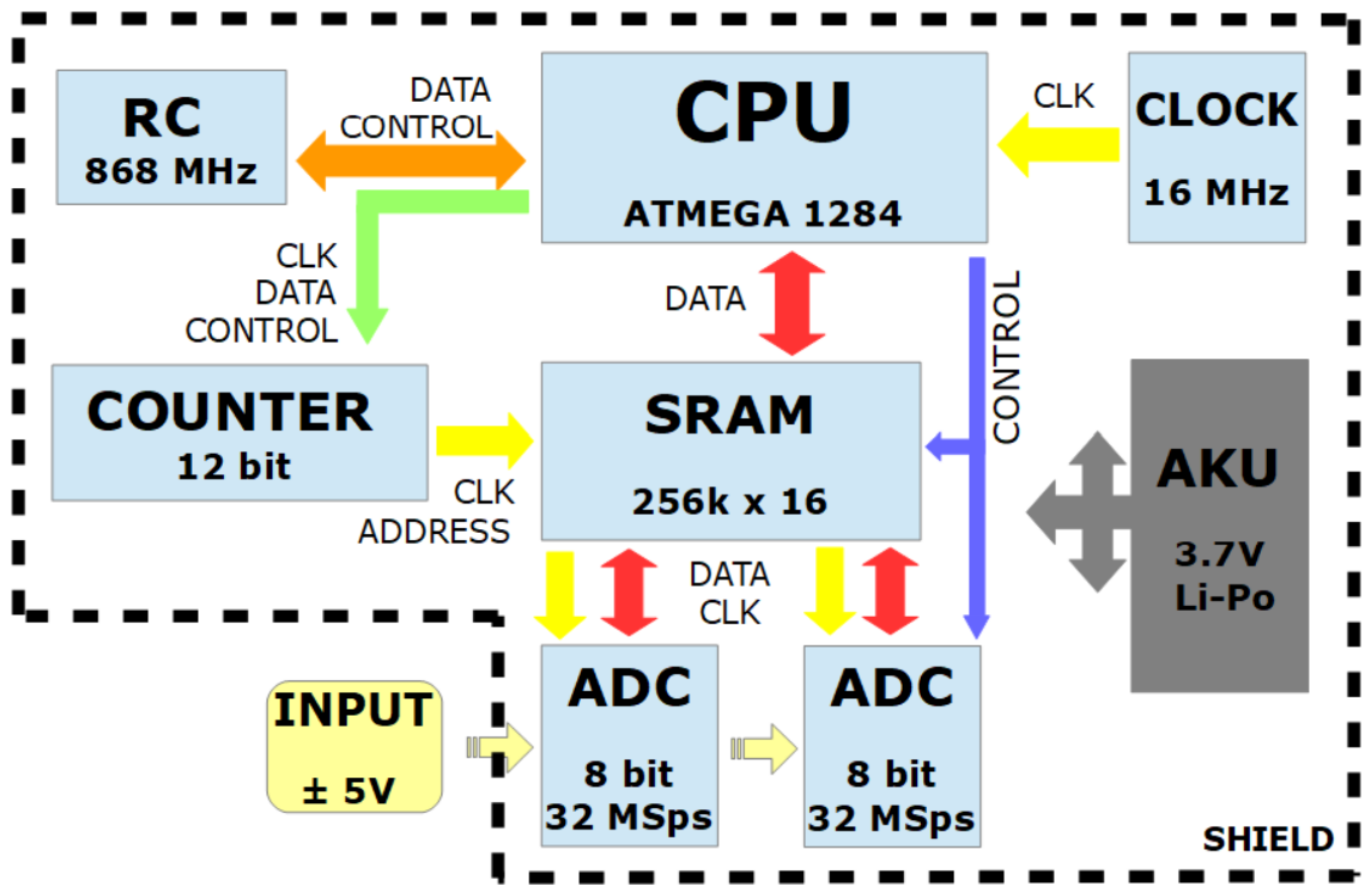

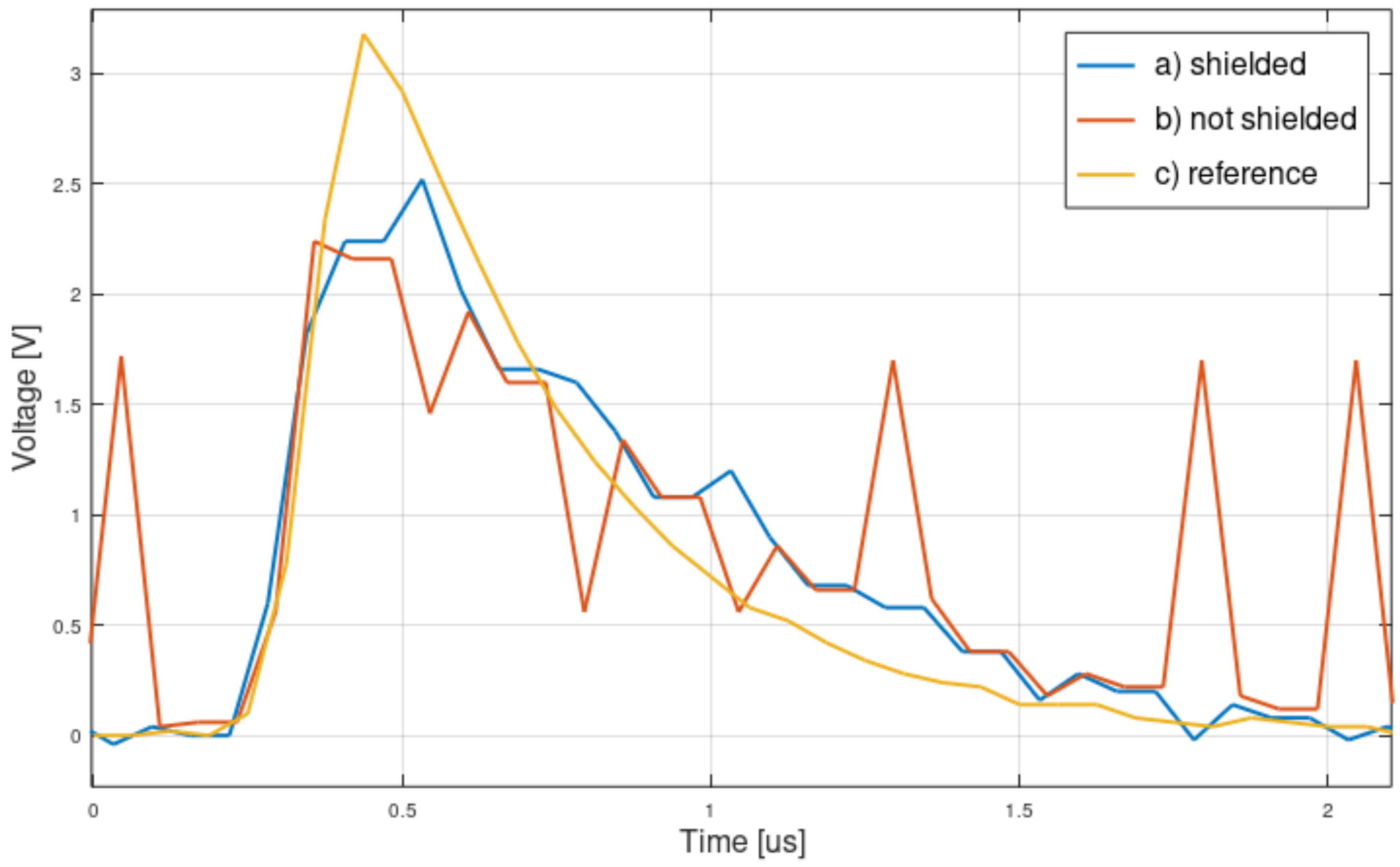
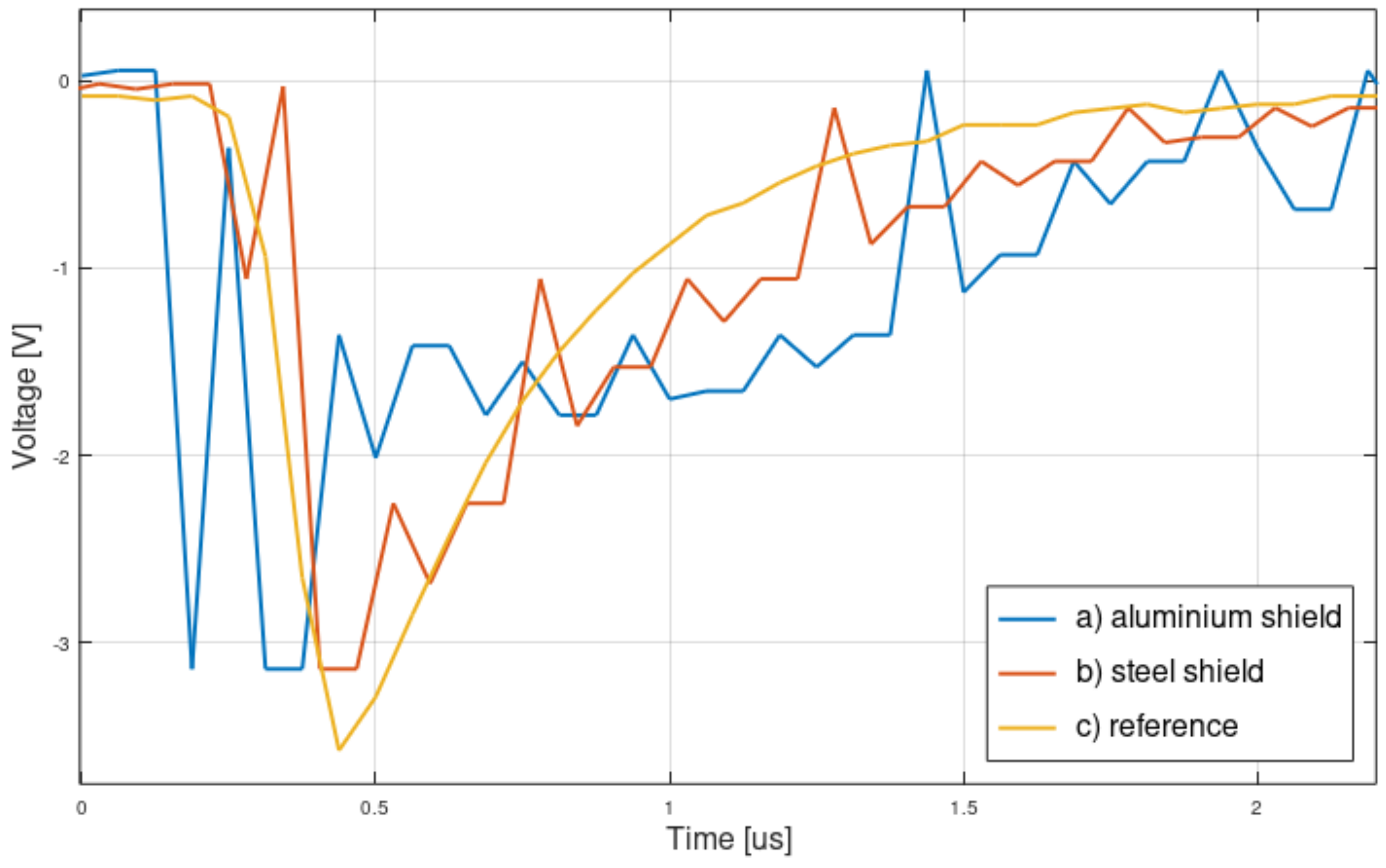
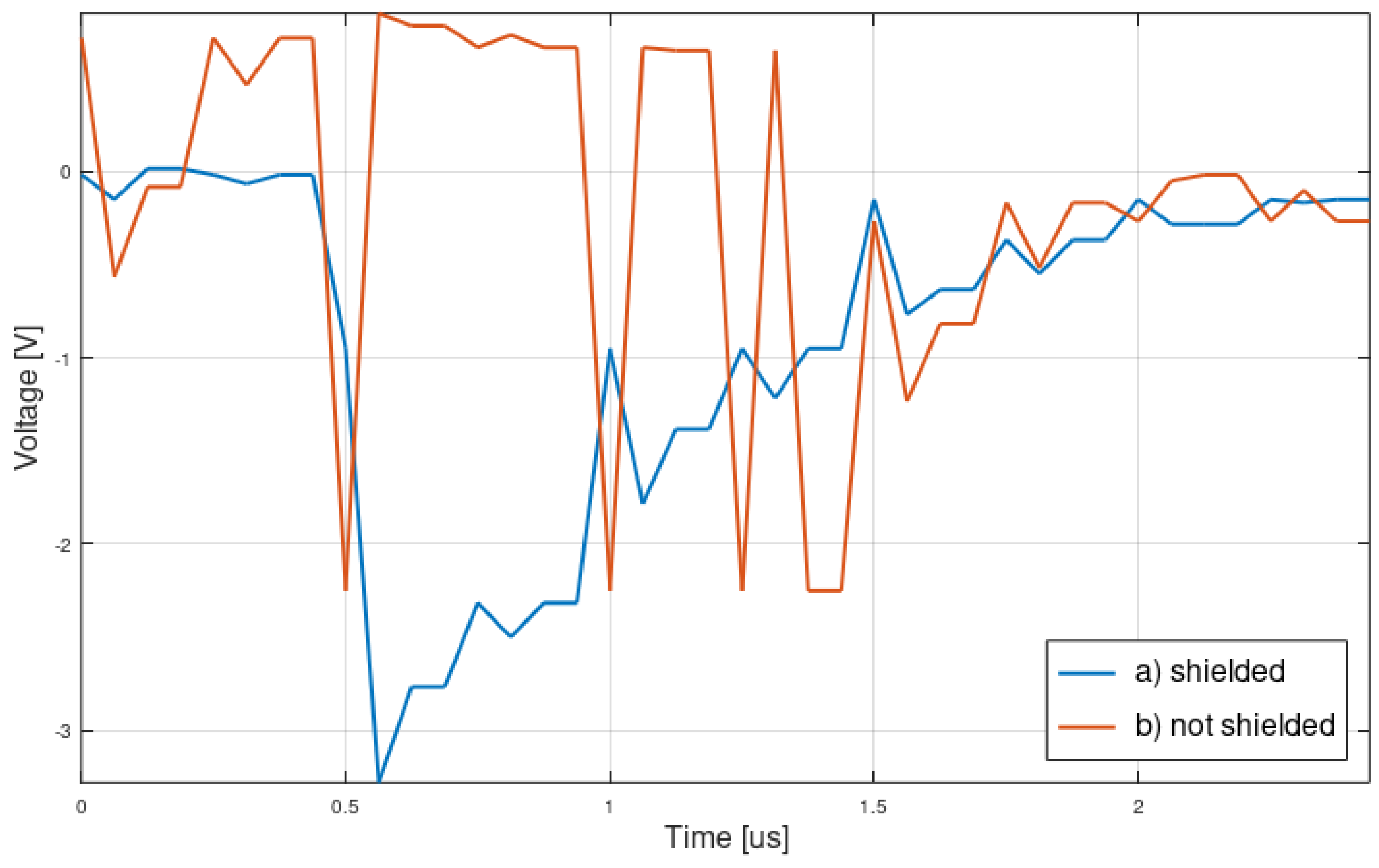
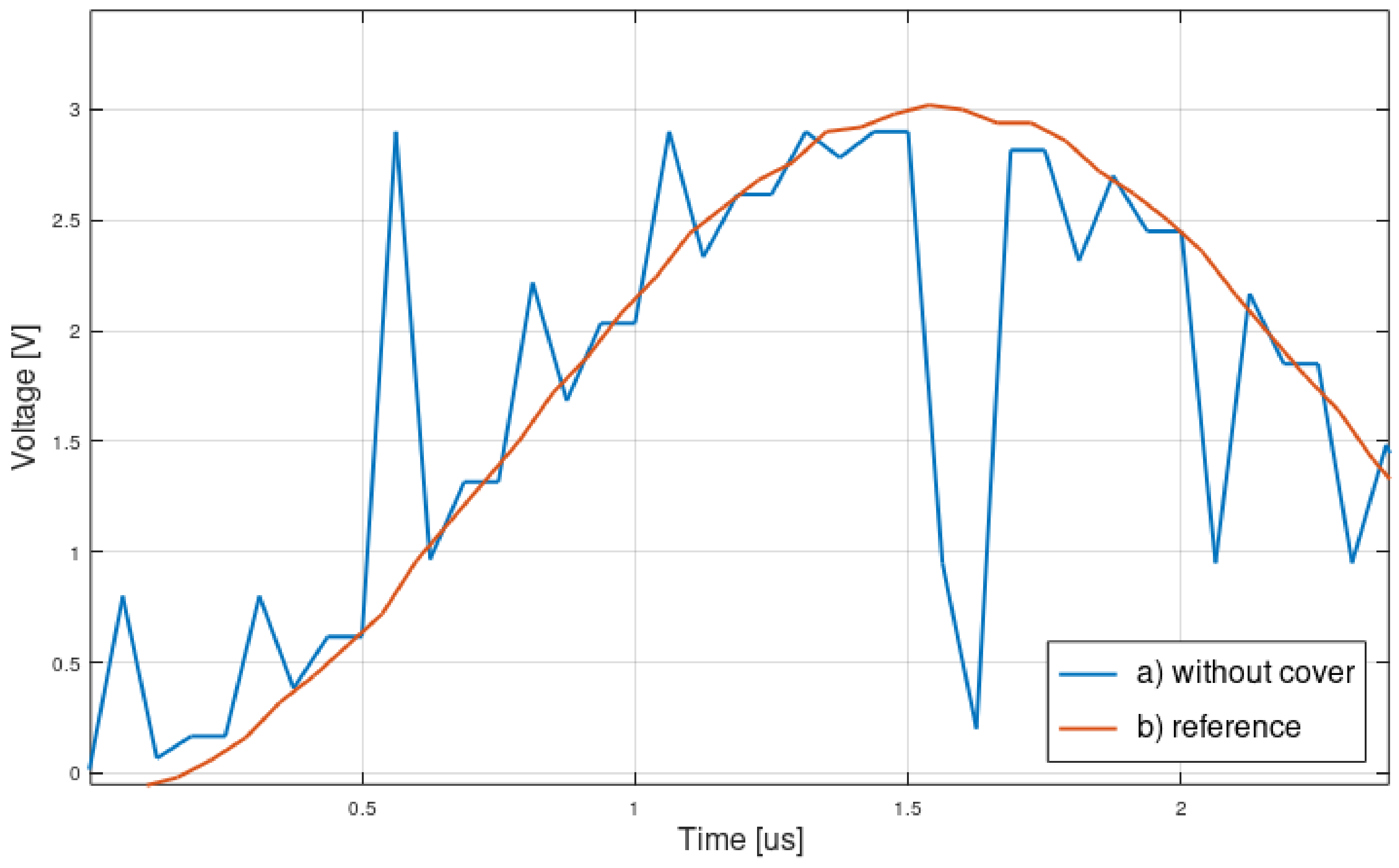
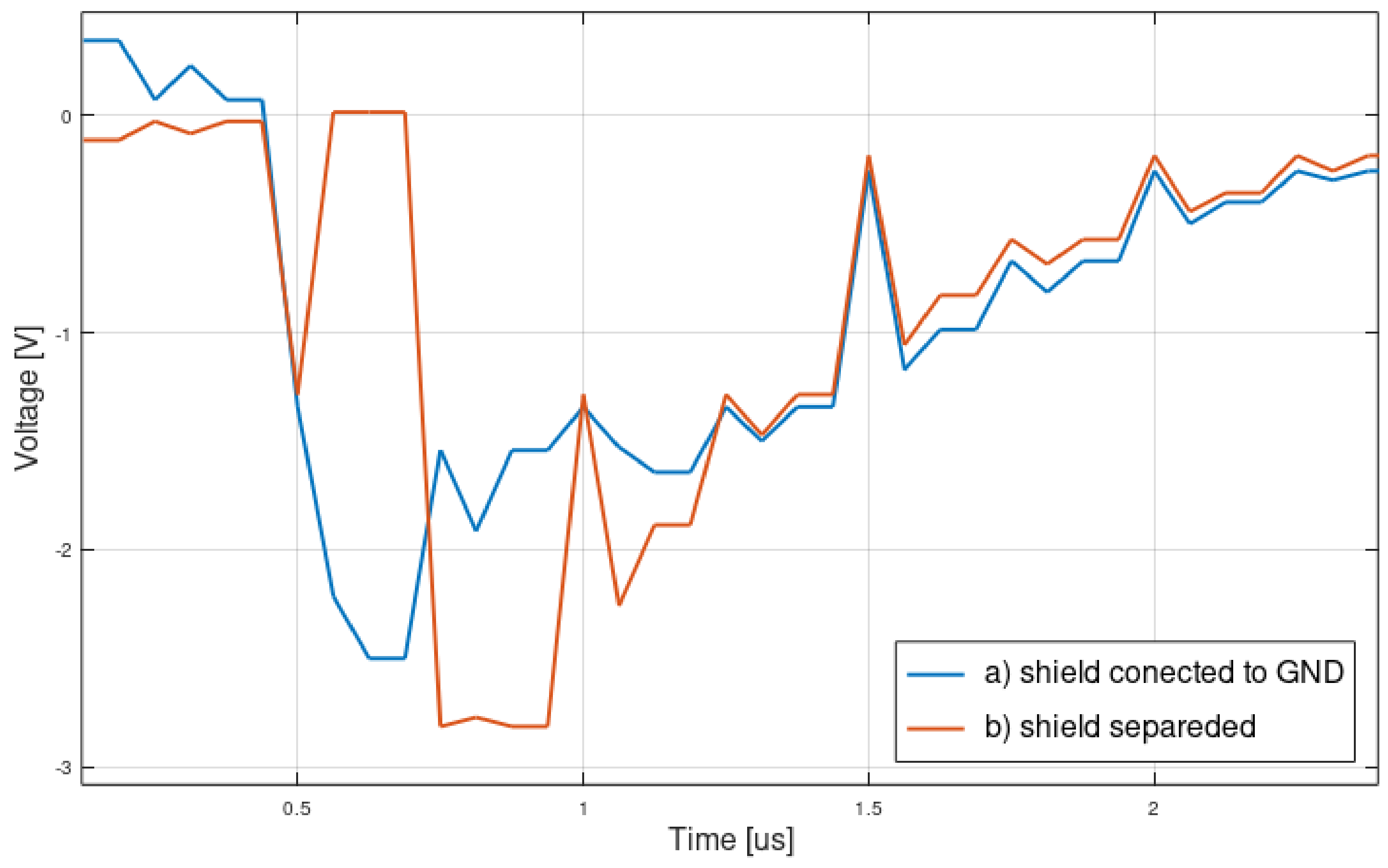

| Type | Proposed Prototype | Optical Fiber [2] | Scope RIGOL DS1054Z [47] | High-Voltage Line Detector [33] | Rogowski Coil in Wind Turbine [31] |
|---|---|---|---|---|---|
| Ver. Resolution | 16 bit | 12 bit | 8 bit | 16 bit | 11 bit |
| Sampling | 16 MS/s | 100 MS/s | 1 GS/s | 400 kS/s | 4 MS/s |
| Wireless | YES | NO | NO | YES | YES |
| Communication | RF | Optical | Wire | GSM | Wireless |
| Dimensions | 8 × 5 × 5 cm | 20 × 20 × 20 cm | 16 × 12 × 31 cm | ~20 × 20 × 50 cm | No data |
| Power Supply | Battery | Battery | Battery/230 V | Self-powered | 230 V |
| Working time | >12 h | 1–2 h | No data | No data | No data |
| Mobility | High | Medium | High (batt.) | Low | Low |
| Safety | High | High | Low | High | High |
Publisher’s Note: MDPI stays neutral with regard to jurisdictional claims in published maps and institutional affiliations. |
© 2021 by the authors. Licensee MDPI, Basel, Switzerland. This article is an open access article distributed under the terms and conditions of the Creative Commons Attribution (CC BY) license (https://creativecommons.org/licenses/by/4.0/).
Share and Cite
Kossowski, T.; Matuszewski, Ł. Non-Real-Time Wireless System for Lightning Effect Measurements. Appl. Sci. 2021, 11, 4204. https://doi.org/10.3390/app11094204
Kossowski T, Matuszewski Ł. Non-Real-Time Wireless System for Lightning Effect Measurements. Applied Sciences. 2021; 11(9):4204. https://doi.org/10.3390/app11094204
Chicago/Turabian StyleKossowski, Tomasz, and Łukasz Matuszewski. 2021. "Non-Real-Time Wireless System for Lightning Effect Measurements" Applied Sciences 11, no. 9: 4204. https://doi.org/10.3390/app11094204
APA StyleKossowski, T., & Matuszewski, Ł. (2021). Non-Real-Time Wireless System for Lightning Effect Measurements. Applied Sciences, 11(9), 4204. https://doi.org/10.3390/app11094204









